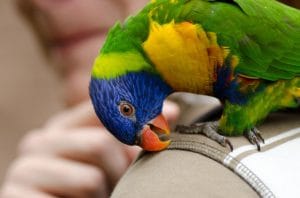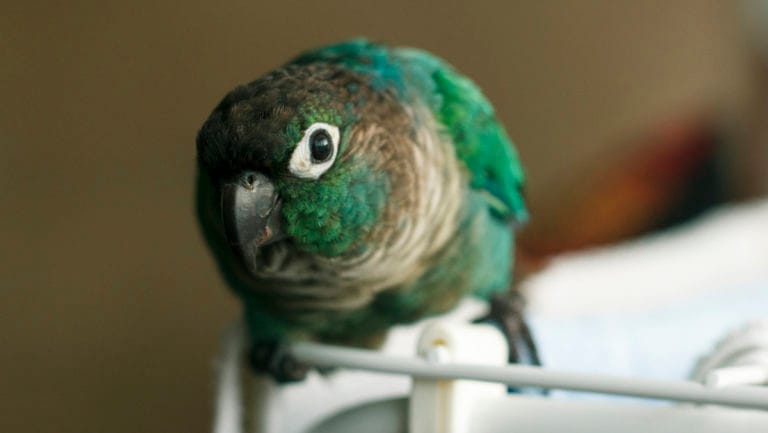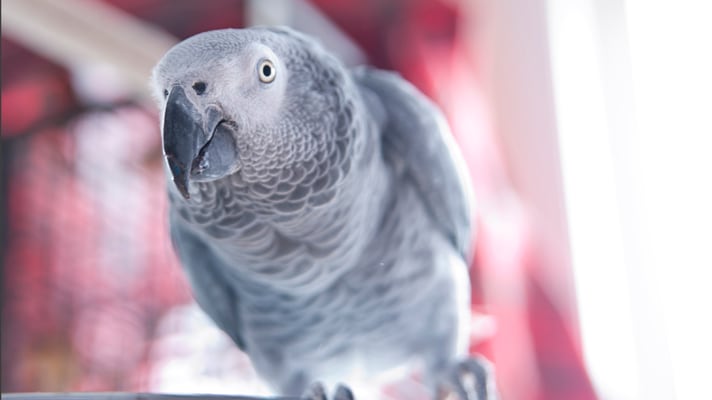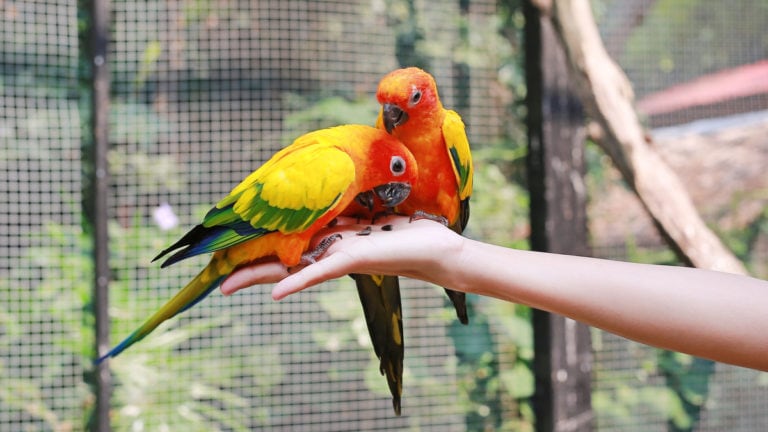When I first became enamored with parrots as a youngster, it was because I imagined having my very own pet bird happily perched on my shoulder, nuzzling my neck and gently talking in my ear. When I finally saved up enough allowance and whatever spare change I could scrounge up, I made sure my big brother followed through on his promise to accompany me to the pet store so I could pick out my bird. I couldn’t have been more excited to bring home Elvis, my cockatiel.
Elvis wasn’t close to being hand-tamed but that didn’t stop me from insisting he perch on my shoulder. When I finally got him to actually perch there, he directed his protest at my ear, hissing and then charging at my earlobe; not quite breaking the skin but inflicting an affective pinch. Even though Elvis and I started off on the wrong foot, after I started all over with baby steps like getting him to perch on my hand, we managed to foster a friendship that spanned 21 years. Much of our time together included him contently perched on my shoulder playing with my hair and tickling my neck while I did homework or watched TV.
Years later, I adopted a male double yellowed-headed Amazon parrot, Sunshine. But there was no way I was going to offer my shoulder as a perch. It was right after my first bird conference and where I met a woman with a stitched-up nose and swollen lip. She explained that she did something to frighten her macaw, and he reacted by biting into her face. She actually had an appointment for some “minor corrective surgery.”
With Elvis, I was OK with the thought of a potential nip if I did something to offend him, because even his fiercest pinch was something I could physically and emotionally get over within a short period of time; I could handle the potential aftermath of an irate, even downright angry cockatiel inflicting his biggest, baddest bite. With Sunshine, however, I knew his bite could involve a band-aid or even stitches. That was the difference for me; an Amazon parrot’s beak packed a much bigger punch, and I didn’t want to risk it.
Inherent Risks With Parrots On Shoulders
But still, there are many pet bird people who share their shoulders with their parrots, large and small. (Actually, parrotlet expert Sandee Molenda pointed out that parrotlets have a hard time holding onto a person’s shoulder because their feet and stance are so small, they often slide off.) The other problem is that it can be a downright challenge to get a parrot off of your shoulder if it is determined to stay there and, again, you might be looking at a bite that could be directed at your face, ear/shoulder/cheek when you insist your bird step off.
Many experts warn against it, mostly because you can never be 100-percent positive that something won’t frighten, irritate or anger your parrot and cause it to lash out at you.
In her book, “The Companion Parrot Handbook,” avian behavior consultant Sally Blanchard points out that eye contact is one of the best ways to establish control or discipline with a misbehaving parrot. When your bird is on your shoulder, you can’t make eye contact without making your face vulnerable to injury should the bird attack.
According to Blanchard, “A parrot that has been consistently allowed on the shoulder may create serious problems as it becomes more territorial. Parrots bond strongly to their primary person’s face. If they are bonded to us and we allow them to sit on our shoulder, I believe their perception is one of sitting together with us on one moving branch. Our body becomes their territory. If that territory is threatened by any intruder (your husband, wife, child, dog, etc.) it is instinctive for the bird to defend that territory.” Blanchard then points out that the parrot can’t defend both its “mate” (you) and your mutual territory, so it bites you so you’ll flee to safety and leave it to defend the territory. The only problem, of course, is that you can’t flee your own shoulder.
Margaret A. Wissman, DVM, noted some potential hazards to a bird perched on the shoulder, such as a fall if the pet bird has a recent nail trim and can’t hold on. Wissman has also seen parrots with strands of hair wrapped around a toe, causing constriction and lack of blood flow to the toe. “Human hair is strong and can wrap around a toe, cutting deeper and deeper into live tissue,” Wissman said.
Breaking The Shoulder Perching Habit
Shoulder perching can be a hard habit to break in parrots. Once a parrot is used to this high perch spot, it can be very adept at running up the arm and reaching this destination before you have time to react. A common mistake many people make when trying to discourage a bird from climbing onto the shoulder is to drop their hand/wrist once the bird starts to walk up the arm; this now makes the shoulder even more attractive because birds prefer to climb up, not down. A better reaction is to raise your hand above shoulder level and dip your elbow to distract it, and then quickly have the bird step up on your other hand.
Your Parrot Must Respect The Shoulder
Once you have received a bite to the facial area, there is no guarantee that it won’t happen again, even if you were at fault (e.g. you suddenly stood up, which spooked your pet bird or you didn’t notice your bird’s body language telling you that it wanted to go back to its cage, etc.). Unless you are OK with the possibility of a nip or bite, taking into account that the bigger the beak, the bigger the bite—think cockatiel pinch versus macaw chomp—re-training your bird to perch on your lap or hand is a safer way to go. This might take some persistence on your part—having your pet bird step up onto your hand each time it heads for your shoulder and then returning it to a more acceptable place to perch—but your bird will eventually get it.
One factor to consider before allowing your pet bird to perch on your shoulder is the bird’s age. A younger bird is less likely to become aggressive/territorial than when it reaches sexual maturity. Your bird might be a respectful shoulder-perch buddy for years and then one spring day, it suddenly becomes aggressive. The species and gender of the parrot can also be factors when hormones are involved.
The shoulder, more so than any other perch spot, must be treated with respect; after all, your face is at stake. If your parrot respects that it can be there only when you allow it (and not by running up your arm and putting up a fight when you ask it to step off), you’re more likely to avoid trouble. But there is always the potential that a bite could come—can you take it?
Shoulder Rules
Blanchard offered four rules for allowing your parrot on your shoulder:
- The parrot is not allowed on your shoulder unless you put it there. Instead of allowing the bird to run up your shoulder, use the “OK” cue to place the bird there and the “Down” command every time you remove the bird from your shoulder.
- The parrot is allowed on your shoulder only if it readily steps onto on your hand when requested, such as with the “Up” command. (A bird that “attacks” your hand to stay on the shoulder should not be allowed there.)
- Your bird is banned from your shoulder if it has ever displayed aggression while perched there. Be especially careful of the bird’s body language if others are in the room; some birds are OK on their person’s shoulder when no one else is around.
- Don’t assume your bird will behave on your shoulder. Give your bird something to do while it is there, like a foot toy. Don’t inadvertently reward shoulder misbehavior by yelling at the bird, giving it a “drama reward.”
Posted By: Chewy Editorial
Share:









